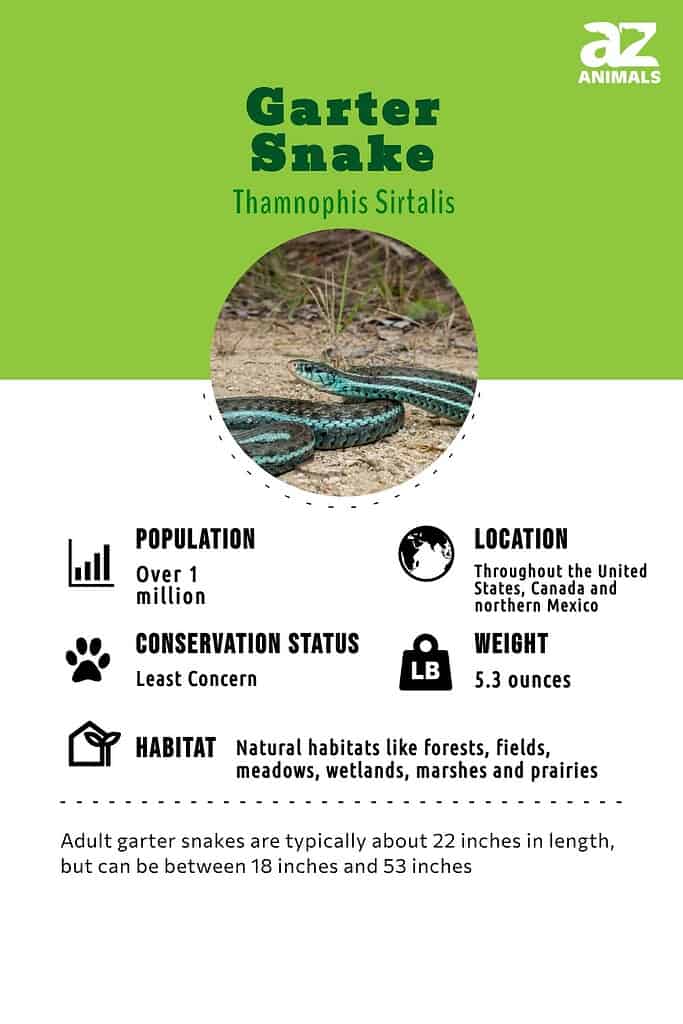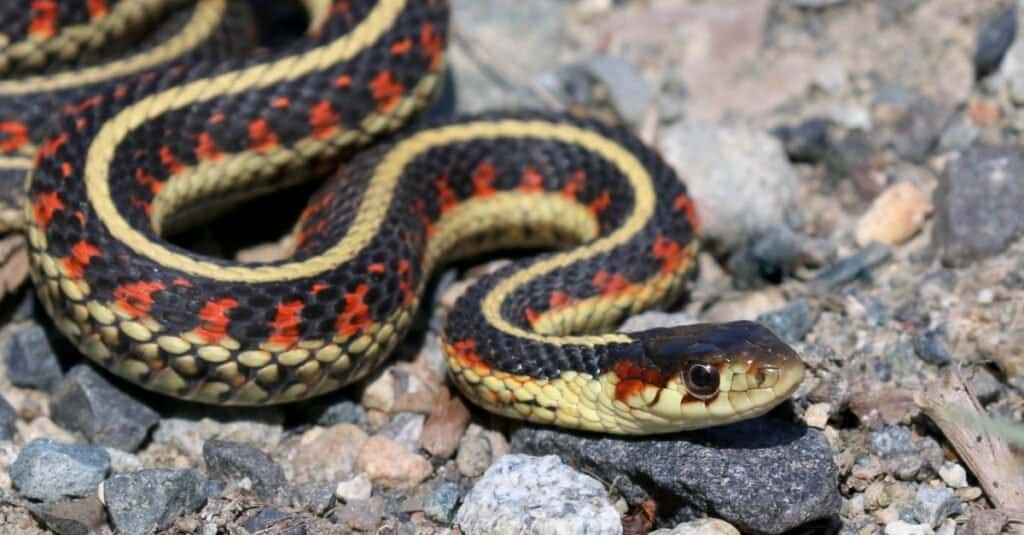Garter Snake
Thamnophis sirtalis
Female garter snakes give birth to live young rather than laying eggs!
Advertisement
Garter Snake Scientific Classification
- Kingdom
- Animalia
- Phylum
- Chordata
- Class
- Reptilia
- Order
- Squamata
- Family
- Colubridae
- Genus
- Thamnophis
- Scientific Name
- Thamnophis sirtalis
Read our Complete Guide to Classification of Animals.
Garter Snake Conservation Status
Garter Snake Facts
- Prey
- Small fish, amphibians, frog eggs, lizards, leeches, earthworms, slugs, snails, insects, snails, crayfish, small birds, rodents and other small mammals, other snakes
- Fun Fact
- Female garter snakes give birth to live young rather than laying eggs!
- Estimated Population Size
- Over 1 million adults in the wild
- Litter Size
- 10-40 live young
View all of the Garter Snake images!
The most common, widespread, and easily identified snake in North America.
The garter snake (Thamnophis sirtalis), also known as the common garter snake, is native to North America. There are 13 subspecies of varying colors and patterns found in a wide range of habitats from Quebec to Florida and British Columbia to Texas. Subspecies of the snake are also found as far southwest as California and in parts of northern Mexico.
Although the snake is generally harmless to humans and considered non-venomous, its saliva does contain trace amounts of venom that may be toxic to its prey. The common garter’s bite itself is not dangerous to small prey. But the saliva is dangerous enough to subdue small animals like mice.
An interesting characteristic of the common garter snake is its ability to recycle toxins from poisonous animals like the American toad and rough-skinned newt. The snake absorbs the toxins into its own body, in turn making itself poisonous to predators like birds.
This adaptation helps the snake survive in the wild, where they typically have a lifespan of 4 to 5 years. In captivity, their lifespan is up to 10 years.

How Do Garter Snakes Reproduce?
Another interesting facet of the snake’s life is how it reproduces. Reproduction often takes place in the form of “mating balls.” These balls are made up of one or more females intertwined with a multitude of males all at once, as part of which fertilization occurs.
This unique method for mating takes place because male populations so greatly outnumber females, and competition for mating is fierce.

Reproduction often takes place in the form of “mating balls.”
©spatuletail/Shutterstock.com
5 Incredible Garter Snake Facts!
- As the most widely distributed snake in North America, it is common to run across this species while gardening or working outdoors
- The common garter snake gives birth to between 10 and 40 immediately independent live baby snakes
- They can maneuver their bodies into more defensive postures than other types of snakes
- During mating season, they form “mating balls” of one or more females and a dozen or more males
- Garter snakes are an excellent means of pest control in the gardens and urban areas they inhabit

A garter snake is an important part of a healthy ecosystem.
©iStock.com/Katie Duncan-Burt
Evolution and Origins

©Alyssa Metro/Shutterstock.com
The genus name has its roots in Greek, with thamnos meaning bush and ophio meaning snake. Sirtalis, originating from Latin, refers to the garter and is apparently linked to the dorsal stripe(s).
The subspecies name, on the other hand, is derived from Greek, with tetra signifying four and taenia indicating ribbon.
During the summer of 2011, Jonathan Crowe, a snake keeper from Quebec, was the owner of a Butler’s garter snake that was 10.5 years old.
Despite typically having a shorter lifespan, this particular snake outlived others of its kind that Crowe had previously owned. Born in 2000, the snake lived on a diet of mice, which is customary for its species.
Where To Find Garter Snakes
Subspecies of the garter snake are found in the United States, Canada, and northern Mexico. But populations of these snakes are sparse and limited in the desert southwest.
Although they will live in vacant lots and other urban areas, the snakes prefer to make their home in natural habitats like forests, fields, meadows, wetlands, marshes, and prairies.
They are commonly found near water sources like ponds, streams, lakes, and rivers, from sea level to mountain altitudes. The snake is diurnal, but their precise daily routine and sleep patterns vary according to regional climate.

Scientific Name
All garter snakes belong to the genus Thamnophis, which has 30 species. They are in the order Squamata, the largest order of reptiles. Their snake family Colubridae is the largest family of snakes with 249 genera. Water snakes are of the genus Nerodia and are closely related.
The common garter snake (Thamnophis sirtalis) is a species with 13 subspecies all frequently and simply referred to as “garter snakes.” Thamnophis sirtalis is in the family Colubridae and genus Thamnophis. The scientific name comes from the Greek words thamnos, meaning bush, and ophio, meaning snake, in combination with the Latin sirtalis, meaning like a garter.
The 13 subspecies of Thamnophis sirtalis include:
- Eastern garter snake – Thamnophis sirtalis sirtalis
- Red-sided garter snake – Thamnophis sirtalis parietalis
- California red-sided garter snake – Thamnophis sirtalis infernalis
- Red-spotted garter snake – Thamnophis sirtalis concinnus
- New Mexico garter snake – Thamnophis sirtalis dorsalis
- Puget Sound garter snake – Thamnophis sirtalis pickeringii
- San Francisco garter snake – Thamnophis sirtalis tetrataenia
- Chicago garter snake – Thamnophis sirtalis semifasciatus
- Maritime garter snake – Thamnophis sirtalis pallidulus
- Texas garter snake – Thamnophis sirtalis annectens
- Valley garter snake – Thamnophis sirtalis fitchi
- Blue-striped garter snake – Thamnophis sirtalis similis
- [Unnamed common garter snake found in Chihuahua, Mexico] – Thamnophis sirtalis lowei
The 13 Different Types of Garter Snakes
The 13 types of common garter snakes are mostly defined by the geography in which they are found. However, there are wide-ranging differences in colors, patterns, sizes, and some other characteristics with these subspecies. They can even differ in the defensive postures the snake will take when threatened by predators or humans.
The 13 sub-species include:
- Eastern garter snake – Thamnophis sirtalis sirtalis is found in the eastern United States where it was first discovered in 1758. In Georgia and Florida, this subspecies features bright blue background colors but is brown, gray, or reddish in other regions where it is found.
- Red-sided garter snake – Thamnophis sirtalis parietalis is found from the Northwest Territories of Canada to northern Texas.
- California red-sided garter snake – Thamnophis sirtalis infernalis typically features blue or yellow stripes on a black and red background. It is found in California as its name implies, with females usually growing no larger than 39.5in, about 10 inches longer than males.
- Red-spotted garter snake – Thamnophis sirtalis concinnus is found in northwestern Oregon and southwestern Washington state habitats.
- New Mexico garter snake – Thamnophis sirtalis dorsalis lives in New Mexico as its name implies. It is also found in northern Mexico.
- Puget Sound garter snake – Thamnophis sirtalis pickeringii is named for the Puget Sound of Washington state, part of the region where it lives. The snake is also found in British Columbia and on Vancouver Island.
- San Francisco garter snake – Thamnophis sirtalis tetrataenia lives in San Mateo and Santa Cruz counties of the San Francisco Bay Area. This is the only common garter snake species designated Endangered by the IUCN. It is believed there are only 1,000 to 2,000 of the snakes left in the wild.
- Chicago garter snake – Thamnophis sirtalis semifasciatus is native to the Chicago area and northeastern Illinois. This snake is usually dark brown or black with yellow or gray longitudinal stripes.
- Maritime garter snake – Thamnophis sirtalis pallidulus is found in New England in the United States and Quebec and maritime provinces of Canada.
- Texas garter snake – Thamnophis sirtalis annectens lives mostly in central Texas, but is also found in Kansas and as far north as South Dakota. This dark green to black colored snake features bright red and yellow stripes down its patterned back.
- Valley garter snake – Thamnophis sirtalis fitchi became a named subspecies of the common garter snake in the 1950s. It is native to the Rocky Mountains and interior ranges of the United States.
- Blue-striped garter snake – Thamnophis sirtalis similis features bright blue striping from neck to tail and lives in northwestern peninsular Florida.
- [Unnamed common garter snake found in Chihuahua, Mexico] – Thamnophis sirtalis lowei is found in Chihuahua, Mexico, and has been a named subspecies of the common garter snake since 1988.

The blue-striped garter snake is found in Florida and can come in a few colors. Most notably, they can come in a striking shade of blue.
©Jay Ondreicka/Shutterstock.com
Population and Conservation Status
According to the International Union for the Conservation of Nature’s (IUCN) Red List of Threatened Species, the common garter snake species (Thamnophis sirtalis) as a whole is of “Least Concern.” This classification means that the population is stable as of the last surveys in 2007. The population size estimation is over 1 million adults in the wild.
However, the U.S. Fish and Wildlife Service and the Environmental Protection Agency both list the subspecies San Francisco Garter Snake as “Endangered.” Threats for common garter snakes throughout North America include habitat loss and over-collection. In northern Mexico the small populations of garters there are threatened by changes in water availability.
Appearance and Description

Garter snakes have three stripes that run the length of its body.
©iStock.com/randimal
Common garter snakes include 13 subspecies of varied colors and patterns from throughout the United States, Canada, and northern Mexico. Colors can range from dark brown, gray, green, or black to bold patterns with colors like red and blue. Most of the snakes have a dark body, white or cream-colored belly, and long stripes running from neck to tail. The stripes are usually yellow or white, but can also be red, blue, or other colors.
Because of their extreme color variations, the best way to identify a common garter snake is to look for three light stripes running the length of its body. If the snake sticks its tongue out, you can see it is bright red with a black tip. Adult garter snakes are typically about 22 inches in length but can be between 18 inches and 53 inches. Baby common garters are born from 4.5 inches to 9 inches long and look much like adult snakes in miniature.
How to identify a garter snake:
- Dark patterned or solid background colors on the body
- Three yellow, white, red, or blue stripes running lengthwise from neck to tail
- Adults average 22 inches in length, baby length is from 4.5 to 9 inches
- Thin body
- Red tongue with black tip
Garter Snakes: Male vs Female
The identification of male vs female is relatively easy, although it’s possible to find anorexic females and very large males. Females are larger than males, being about three feet long as opposed to two feet. They are also bulkier.
This is because females give birth to live young rather than laying eggs and they have to conserve energy for their young, whereas males spend time pursuing females and fighting other males during mating season. Like other snakes, males have thicker tails than females.

Garter snakes have large heads with small eyes.
©iStock.com/randimal
Venom: How Dangerous Are They?
These snakes do have enough venom in their saliva to subdue some types of prey. For example, a bite from a common garter snake can pass enough venom from the snake’s mouth into a mouse’s bloodstream affecting the prey’s breathing or other functioning.
If a human, cat, or dog is bitten by a common garter snake, the outcome is usually slight irritation and swelling at the wound site, at most. It may be possible for some people to have an allergic reaction to the snake’s saliva. This is rare but reportedly can happen.
For this reason, contact your doctor if you are bitten by a common garter snake and experience anaphylaxis symptoms like nausea, vomiting, hives, or dizziness. Otherwise, simply wash the bite area using warm, soapy water to prevent infection from the bacteria common to a snake’s mouth.
Behavior and Eating Habits
These snakes can be beneficial to gardens because their diet includes an array of insects such as snails, grasshoppers, and slugs, and they also eat small rodents. The snake’s presence provides excellent pest control. For this reason, it is a good idea to leave garter snakes where they are found outdoors.

To learn how to keep garden snakes away from your garden, read here.
Similar Animals
View all 170 animals that start with GGarter Snake FAQs (Frequently Asked Questions)
Are common garter snakes venomous?
Common garter snakes are not venomous to humans. But they do have enough venom in their saliva to subdue small prey like mice. A bite from one of these snakes rarely harms humans or large pets like cats and dogs.
How do common garter snakes hunt?
Common garter snakes use the ambush method of hunting their prey like frogs, insects, worms, small rodents, snails and grasshoppers. They typically coil in a garden and await passing prey, then using their lightning-fast reflexes to attack. These snakes have excellent senses of smell and sight that aid in their hunting.
Are common garter snakes aggressive?
Common garter snakes are not usually aggressive around humans. They have excellent eyesight and know to avoid large predators. Instead, the snake will try to flee to safety. However, split-second reflexes and keen senses enable the common garter to be aggressive in hunting its prey.
Where do common garter snakes live?
Common garter snakes live throughout the United States, Canada and northern Mexico. The area where they are least present is in the desert southwest. But they are found in New Mexico and California. Their preferred habitat is near a water source and in a wide range of climates from sea-level to mountain heights.
What do common garter snakes eat?
A common garter snake’s preferred foods are insects, amphibians and earthworms. But they also like to eat small rodents, snakes, fish and birds.
Are common garter snakes harmless to humans?
Common garter snakes are relatively harmless to humans. They do not have enough venom in their saliva to affect a bitten human beyond the potential for skin irritation and swelling. In fact, the snakes are actually helpful to humans, reducing the number of pests in our gardens and residential areas where they live.
Is a common garter snake friendly?
The common garter snake is not really friendly. But it can become tame with lots of calm, gentle handling over an extended period of time. Some people keep these snakes as pets. But in many regions, taking one of these snakes out of its habitat is illegal and punishable by law.
How big do common garter snakes get?
A baby common garter snake is born at a size of 4.5 inches to 9 inches in length. The average adult grows to about 22 inches. However, some of these snakes have grown to as long as 53 inches, although that is rare. Females are typically about 10 inches longer than males.
Thank you for reading! Have some feedback for us? Contact the AZ Animals editorial team.
Sources
- Wikipedia / Accessed May 9, 2022
- iNaturalist / Accessed May 9, 2022
- Portal CT Government / Accessed May 9, 2022
- Animal Diversity / Accessed May 9, 2022
- Britannica / Accessed May 9, 2022
- Vermont Fish & Wildlife / Accessed May 9, 2022
- Bio Kids / Accessed May 9, 2022
- Florida Museum / Accessed May 9, 2022
- Nature / Accessed May 9, 2022
- ITIS / Accessed May 9, 2022
- Herp Net / Accessed May 9, 2022


















